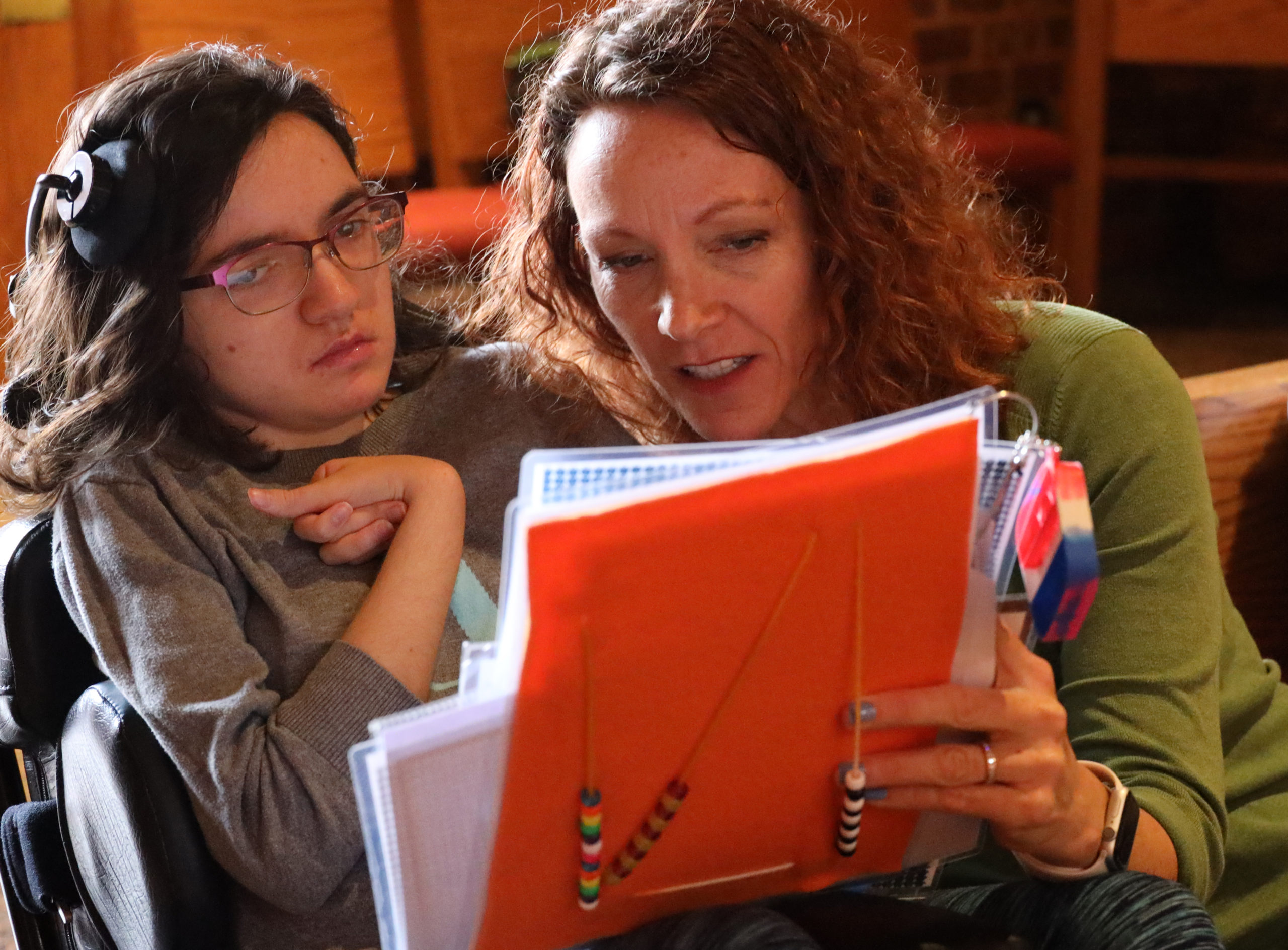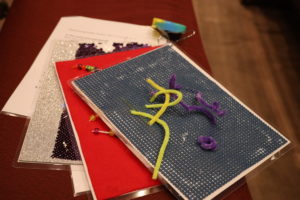
Connie Grover, right, and daughter Anna, follow along with the readings during a sensory-friendly Mass March 20 at St. Columbkille Church in Papillion. SUSAN SZALEWSKI/STAFF
News
Sensory-friendly Mass offers a sense of belonging and acceptance
March 24, 2022
Getting a family ready and out the door for Mass each week is not always easy. When a family member has special needs, it can seem insurmountable.
“These are families that probably, upon waking, started planning and making adjustments to the daily schedule and routine just to get to church,” said Connie Grover, a member of St. Columbkille Parish in Papillion.
Connie and her husband, Doug, don’t have the luxury of arriving at Mass just as the opening hymn begins to play, either. Their 20-year-old daughter, Anna, has special needs and is in a wheelchair. To find a seat that will accommodate their family means arriving 10 to 15 minutes before Mass begins.
However, one weekend a month, Mass is easier for the Grover family. On the third Sunday of the month, St. Columbkille offers a sensory-friendly Mass for people with special needs and their families.
According to the National Catholic Partnership on Disability (NCPD), sensory-friendly Masses include lower lighting, softer music, Scripture readings from the Children’s Lectionary, and shorter, more literal homilies. Families and individuals can get up and move, bring fidgets or noise-canceling headphones, and “participate in the liturgy just as they are.”
More parishes across the United States are implementing sensory-friendly Masses, but there is tremendous room for growth. Currently, St. Columbkille is one of only 12 parishes in the nation listed on the NCPD’s website as having a sensory-friendly Mass.
Cathy Campbell is a member of the St. Columbkille Weekend Experience Committee, which aims to make weekends at the parish a positive experience. She explained that, during one of its meetings, a committee member with a child with special needs talked about the difficulties such families face at Mass – if they can get there at all. It was then that the idea for a sensory-friendly Mass at St. Columbkille was hatched.
POSITIVE FEEDBACK
The committee brought in professionals who work with individuals with special needs, Campbell said. They talked to parents, teachers and caregivers to decide how such a Mass would look. Along the way, they received positive feedback from families who said how much a sensory-friendly Mass would mean to them.
The first such Mass was held on Oct. 17, 2021. Father Thomas Greisen, pastor of St. Columbkille, invited Father Tom Magnuson to concelebrate. The plan was to celebrate a sensory-friendly Mass one month at a time. If it went well, they’d do it the following month. It has been going strong ever since.
Campbell said the committee wrestled with the idea of asking one more thing from their priests, who do so much already. That’s when Father Magnuson, who Campbell calls “a special gift,” said he would be happy to celebrate the Mass each month.
“It’s such a privilege for me,” Father Magnuson said. “I look forward to it every month. I really do. This is where I want to be.”
He appreciates that everyone who attends the Mass can just be themselves and find mutual support around the Eucharist.
“You just feel the Lord’s closeness to all of us,” Father Magnuson said. “So many times, something comes along in a priest’s life, and you feel very honored and privileged. This is definitely one moment for me when I’m with everybody there. It’s something I’m very grateful for.”
A NOTICEABLE DIFFERENCE
Those who attend the Mass notice a difference as soon as they walk in the door: the church is dimly lit, and the music is softer.
“It really helps bring the anxiety factor down a notch,” Grover said.
Members of a hospitality group greet families who receive a liturgy handout that is easier to follow than the traditional Breaking Bread Missal. Readings and prayers are printed in a large font on laminated cards held together with a ring. The backs of those laminated cards are covered with sensory material like sequins, fur or pipe cleaners. There is a checklist for the parts of the Mass, making it easier to follow along.

Liturgy handouts including the Mass readings and prayers, printed on laminated cards and backed with sensory materials such as pipe cleaners, are made available to people attending the Mass. SUSAN SZALEWSKI/STAFF
Some people walk around during Mass, but no one seems to notice or care.
“That is why we’re here,” Campbell said. “You can do that.”
Kelly and Frank Graf’s daughter, Madison, 13, has intellectual disabilities. The Grafs, members of St. Columbkille Parish, attend daily Mass, but they never know when Madison might have a problem. They don’t have to worry about that at the sensory-friendly Mass.
“She noticed the lights right away,” Kelly Graf said. “She told me on her own, the very first time we went, ‘I really like this. I like that it wasn’t really bright in here.’ She loves the Mass, and so do I.”
Graf adds that it is hard for people who don’t have a family member with special needs to understand.
“There are a lot of parents that struggle with their kids, and it’s difficult, especially because Catholics want to be at church,” she said.
St. Columbkille parishioners Melissa and Matt Yeshnowski have three children, including a 21-year-old son, Mitchell, born with hydrocephalus. He also has epilepsy. While the family attends Mass each week, they always sit in the back row. They don’t have to do that at the sensory-friendly Mass.
“It is a lot quieter; the lights are a little bit dimmer,” Melissa Yeshnowski said. “It’s not so overwhelming. There is music, but it’s just softer. The homilies are not as long, they’re more literal, so I think he is better able to understand the homily.”
Mitchell enjoys the checklists, as well.
“Some of the people who attend the sensory Mass like to see what is coming next,” Yeshnowski said. “With the checklist, they can see what is coming next and then check that off. Mitchell really likes that.”
The sensory-friendly Mass was a group effort, but when committee members saw how passionate their fellow member Campbell was, they asked her to be in charge. She enthusiastically agreed. She credits her passion for the Mass to having a sister with special needs living in Indiana.
“There is a satisfaction in knowing you’re doing something for a group of people that have those same needs,” Campbell said.
SENSE OF COMMUNITY
The sensory-friendly Mass offers a camaraderie these families have not always found at Mass.
“We realize and respect the challenges each other face and share a knowing smile,” Grover said. “There’s kind of a sense of community. Without even knowing everyone’s names, I know these are families having multiple appointments, multiple specialists, multiple meetings with schools, doctors and therapists.”
Other family members benefit, as well.
“These are siblings who get to see that other siblings have a brother, a sister that doesn’t fit in the ‘typical’ description; that they are not alone,” Grover said.
Yeshnowski is humbled that people are willing to organize this type of Mass for her family and others like them.
“It’s amazing that we have people who want to run this and do this for our fellow community members,” Yeshnowski said. “Cathy Campbell has gone out of her way to do this for us.”
She said one mom came to the sensory-friendly Mass with lots of fidgets for her child, but Cathy already had a basket of fidgets there.
“All families have to do is just show up,” Yeshnowski said. “That’s all they have to do.”
About 10 families regularly attend the sensory-friendly Mass, and the number is growing. However, Campbell said she doesn’t think in terms of how many families show up.
“It would be so easy to say, ‘It’s really not that many,’’’ she said. “But the power it has for those it is serving is remarkable and should not be dismissed.”
The gratitude of those who come to the Mass is a testament to that power.
“The people who come thank us profusely,” Campbell said. “We had a lady in tears one day, saying, “Thank you so much. I have not come to church with my child in the past six years because it is so difficult. Now I can.’”